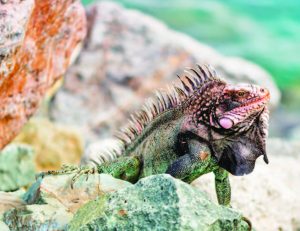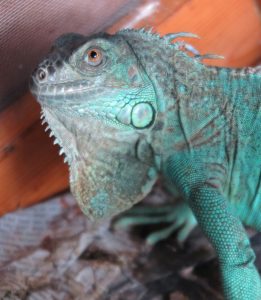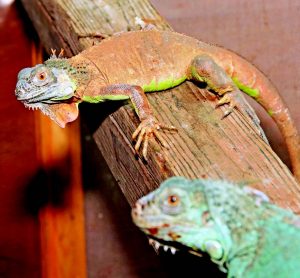Iguanas are one of the most recognizable and popular lizards around the world! However, with exotic-looking hatchlings being more affordable than the domestic dog, many get tempted to buy one on impulse, basing their care on outdated information and misconceptions that could harm the iguana in the long run or, worse, actually kill them!

Just like with any type of pet, proper understanding of the individual animal is key to ensuring that they live a long and happy life.
Here are ten common misconceptions about iguanas that you might not be aware of.
1. Iguanas love to ride on people’s shoulders
Most newly-acquired iguanas can be very skittish, often running or whipping their tails away from the potential “threat”. This can be quite frustrating for someone expecting a docile companion.

Many iguanas in animal sanctuaries have already been socialized at a young age and constantly exposed to people. Getting an iguana to reach that level of ease would take months or even years of interaction.
2. Iguanas can eat bugs, spiders or cat food

One of the first things people assume about iggies is that they are bug eaters, which is not entirely true. Although they are indeed omnivorous, too much animal protein would be harmful to them, causing organ failure. It’s advisable to keep them strictly vegetarian.
3. Lettuce is enough to keep iggies healthy
Yes, lettuce is readily available and is relatively cheap. Iggies don’t seem to mind eating it but it’s not exactly the best food to regularly feed to them due to its lack of nutritional value.

While it’s okay to feed them lettuce, it’s best to mix in other fruits and veggies, such as papaya, kangkong, mustard greens, grapes, bananas, and red bell pepper. Remember: Variety is key!
4. Heat rocks are a good way to keep them warm
Iguanas are arboreal, meaning they like to climb and live on trees, which means they detect heat from above more than from below.

While they really do get warmth from heat rocks, using those can become extremely dangerous — they may be unaware that they’re already getting burned. Please avoid using them.
5. All the light they need can come from a heat bulb
Iguanas depend on heat bulbs for warmth to help digest food. However, unless they have opportunities to actually bask under the sun, it is important to also provide a UVB bulb.
UVB rays help them absorb nutrients and synthesize Vitamin D3 that aids in calcium absorption, preventing metabolic bone disease that could kill them slowly and painfully. These rays also strengthen their immune system and promotes proper organ development.
6. Iguanas grow only to the size of their enclosure
Untrue. Iguanas typically reach around four to six feet in length, so putting them in tiny 10-gallon tanks is detrimental to their well-being.
The final size of an iguana is based on two things: nutrition and genetics. They may take after their parents’ size, or perhaps even get larger if given a good amount of healthy food.
Although stressing them out would indeed stunt their growth, that’s just plain cruel.
7. Iguanas are low-maintenance
People might think iggies are low-maintenance just because they don’t move around much. In truth, they can be very demanding.

Regularly changing their swimming and toilet water, always buying food that perishes quickly, always increasing enclosure size, constantly burning out UVB and heat bulbs and replacing them, making sure they have enough calcium in their diet, making sure their sheddings don’t get stuck, figuring out how to become friends with them — these are just some of what you will need to do. They can really be a handful sometimes, especially if you aren’t used to them.
8. Iguanas have no personality
Although it may be hard to see at first, an iguana’s personality comes out the more you spend time with them.
For example, some iguanas are feistier than others, while some are affectionate and don’t mind being touched. Some are proud and have a certain swagger; others are content just lying on a couch.
9. Handle iggies aggressively to show them who’s boss
Some people would argue that the best way to acclimate an iguana is through aggressive handling: grabbing them roughly from their cages and holding them tightly until they calmed down. The problem with this method is it puts unnecessary stress on the iguana which is detrimental to their overall health. It also teaches them to be afraid of humans.

Tiny, scared baby iguanas aren’t much of a threat since their tail whips, bites, and scratches can’t do much damage. However, having a full-grown iguana, especially a male, with trust issues since childhood could mean a one way trip to the hospital for the people around them. In fact, those who use this cruel method may get frustrated and release them into the wild or give them away.
10. Iguanas don’t drink from bowls
It’s not common, but captive iguanas can drink from water bowls. Of course, their main sources of water include their food, the humidity, and bodies of water where they swim. If they need more water, they could drink like a dog with a water bowl.
Another interesting way to get them to drink is by spraying them on the mouth with a water bottle — it seems to do the trick just fine.
This appeared in Animal Scene magazine’s November 2018 issue.






